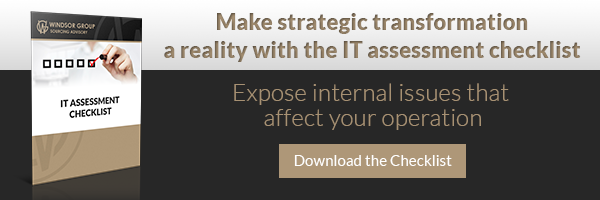 Your company is at a crossroads. You think outsourcing might be a valuable alternative. But where to turn? Here are five signs it’s time for an infrastructure assessment:
Your company is at a crossroads. You think outsourcing might be a valuable alternative. But where to turn? Here are five signs it’s time for an infrastructure assessment:
1. Nothing works.
It’s a whole new world out there, and your infrastructure is, well, not new. In fact your legacy systems are is getting noticeably older. Nothing lasts forever, but it seems like everything is letting you down all at once. Meanwhile new technologies and service delivery alternatives appearing on the market keep increasing and changing. Do you need them? Which ones? And is the cloud really safe, even for your industry?
Learn more with an infrastructure assessment.
2. You’ve run out of room.
“Big” data is the new reality, but it feels like the proverbial elephant in the room. It’s become a physical issue as well as a functional bottleneck. The sheer volume of data being processed and stored around your enterprise is giving you nightmares – you know the one, where data is piling up all around you, you’re being buried in an avalanche of bits and bytes, your company is starting to suffocate … Wake up! This is one dream that’s all too real.
It’s time for an infrastructure assessment
3. Profitability is dropping.
Internally, your CIO and CFO are having more skirmishes. There’s no question IT costs are escalating, and that’s causing related resource management issues. The new initiatives you planned are languishing on the sidelines, because capital is still dedicated to endlessly recurring IT infrastructure refreshment and maintenance.
Externally, your competitors seem to be getting the jump on you, more often. This is not a recipe for growth. Even if you’re the CEO, you’re accountable to someone. If your profitability is slipping, your popularity is slipping with it.
It’s time for an infrastructure assessment.
4. Employees are agitated.
Your crack IT staff can’t keep up any more. Between increasing demands on their time for support, etc. and the massive undertaking necessary just to tread water with evolving technology changes, they’re simply overwhelmed. Worse, they’re retiring. And your HR folks are having a devil of a time finding replacements with the skills and experience necessary to deal with your not-exactly-cutting-edge infrastructure. It’s a puzzle that needs to be solved, and soon.
Meanwhile, employees throughout your enterprise aren’t just working from remote locations, they’re working on the fly. And they’ve grown accustomed to personal technology they want to use at work, too. Like so many other companies, you’re floundering around trying to devise a bring-your-own-device policy that might actually work, recognizing that whatever you decide will have far-reaching ramifications for your IT arrangements.
You need an infrastructure assessment.
5. Increasing regulation.
Certain industries have seen a significant increase in government regulation regarding data safety, etc. And many industries not yet subject to regulatory requirements are asking their businesses to implement new self-imposed standards. Do you meet these standards? Can you? What happens if you don’t? This isn’t something you can sidestep.
Take disaster recovery, for example. New requirements are based on concerns about the efficacy of your plans. If you’re a global enterprise or even a multi-location national company, protecting your far-flung empire is tremendously complex. And while you need to be agile at all times to stay on top of day-to-day business opportunities, nothing tests your ability to roll with the punches and keep operating smoothly like an untimely disaster. How confident are you in your recovery plan?
What you have is a system that’s served you well and helped you grow. But no business environment is static. And these days nothing is more dynamic than IT. So if you’re seeing any or all of these signs, it’s time for an infrastructure assessment that will give you a clear and complete picture of your current status so you can begin to identify the next generation of solutions that will propel and support a profitable future.
Photo credit: Pixabay

